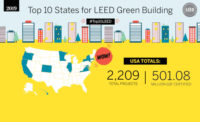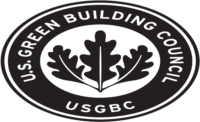LEED, established by the USGBC, the building industry’s leading authority on sustainable design and construction, was officially launched in the Spring of 2000 with the introduction of its first building rating standard, LEED 2.0 for New Construction and Major Renovations (LEED NB). LEED EB was developed to recognize and certify environmental performance in the more than 4.6 million buildings already standing.
During the past two years, the USGBC developed a draft version of LEED EB by taking LEED NB and turning its focus on building upgrades and building operations. It has also gone through the recruitment process for the pilot program, having sent out more than 2,000 invitations for participation to USGBC members, various government agencies, and other interested parties. LEED EB is for the initial and ongoing certification of the sustainability of existing buildings. Building owners that would like their building project to be considered for participation in the LEED EB pilot program may go to www.usgbc.org for more information.
“The response we received from the marketplace is very exciting,” states Michael Arny, chairman of the LEED EB Committee and president of the Leonardo Academy, an environmental and energy issues not-for-profit organization. “It shows that building owners and managers want to use LEED EB to benchmark the continuous operation of their buildings in an environmentally sustainable way as much as architects and construction teams want to build green using LEED NB. Green is proving to be financially beneficial and LEED EB is designed to gather data demonstrating the financial benefits of green building operation.
“The 51 participants in the pilot,” Arny added, “understand that it is not just the 17 million sq ft of space involved in the pilot program that will benefit from their efforts, but the more than 400 million sq ft of space that these organizations cumulatively own or lease that will be influenced by LEED EB.”
The 65 buildings participating in the pilot program offer a good sampling of the general building industry, with commercial buildings representing nearly one-third of the entire program. Additionally, the pilot includes schools, government buildings, university facilities, and a hospital. Projects underway in 23 different states representing all corners of the country in addition to one in Ontario, Canada, and two buildings in Washington. These buildings and the collected data from their improvement projects and programs will help the USGBC fill unforeseen gaps and make any necessary adjustments to the requirements and strategies in the LEED EB rating system. After LEED EB is updated based on what is learned in the pilot, it will be presented to the USGBC membership for approval in an official balloting process in early 2003.
“The objective of pilot testing LEED For Existing Buildings,” notes Steven Winter, chairman of the USGBC’s board of directors and president of Steven Winter Associates, Inc., “is to make certain that this rating system is practical and workable for application in real buildings. It will be an important tool for market transformation to green operating practices in existing buildings and it will also enhance the USGBC’s definition of what a green building is.”
After gaining approval by the USGBC membership, LEED for Existing Buildings will provide guidelines as well as recognition for the ongoing greening building operations. This will give all building owners, facility operators, engineers, and contractors involved in maintenance, upgrades and operational improvements the opportunity to participate in LEED.





